#person of indian origin
Text
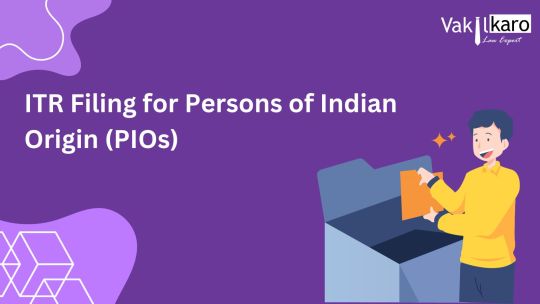
Filing Income-Tax Returns (ITR) is a crucial financial responsibility for every taxpayer. For Persons of Indian Origin (PIOs), understanding the ITR filing process is especially important as it helps maintain compliance with Indian tax laws and ensures the smooth functioning of financial affairs. This article provides a comprehensive guide on ITR filing process for PIOs, detailing the essential steps and information required. Read More
#nri income tax return filing in india#persons of indian origin#persons of indian origin (pio)#persons of indian origin visa#person of indian origin#nri tax filing in india#non resident indian#tds on selling property in india for nri#income tax filing for nri#nri taxation in india#taxation of foreign income in india#itr filing of nri#nri tax in india#non-resident indian and person of indian origin (ethnicity)#income tax return for nri
0 notes
Text
hmmm i have my reservations abt the sexypedia... i think when the concept of the tumblr sexyman was formed into words, people became way too eager to classify things that way. one aspect of a sexyman is the cultural impact, you cant have a sexyman character who fits all the tropes yet doesnt have any cultural impact behind it. the sexypedia even has a class for characters like this which i think is flat out cheating. HOWEVER, it is funny as heck to see who is on that wiki. archibald the asparagus is on there for one
#original nonsense#personal#hal 9000 is there and it says he gets personified as pale twinks this is so tragic. can we get some indian hal rep please.#im going to beat up stanley kubrick for changing dr chandras name in the movie. watch out stanley.#oh i just looked him up and he died. sorry stanley. well he can still get my wrath beyond the grave idc.
13 notes
·
View notes
Text
have tried so many different arab/middle eastern cuisines in the last week but nothing even came close to knocking indian out of the number one spot
#i’ve had: irani afghani falasteeni syrian & shawarma which is just generally arab origin i think#<- generally don’t includ afghani in arab but for the sake of this.#sorry arabtuals </3 but i need my flavour intense in my face and most of the time spicy#it’s the kind of thing i’d go out to eat for fun but not regularly. ig it’s different if u are arab and that’s what you’ve always/mostly#eaten like me with indian. + we went to this authentic mughals restaurant and it was so good it was easily the best food i’ve had since#we’ve been in dubai. im not a fan of arab veg dishes at all they look so interesting and are definitely to the taste of people who like veg#dishes anyway which i don’t i’m not a salad person. the way arabs cook their meat though >>>>>>>>>>#they’re like the good indian seekh kebabs#m
10 notes
·
View notes
Text
Thoughts on Spider-Man: Across the Spiderverse and being different (Pt. 1: Miles Morales)
Just watched Across the Spiderverse and I think regardless of the argument of Gwen being trans or not (and yes, I will get to Gwen), there's something to be said about this movie's handling of the experience of being Spiderman as an allegory for outcasthood (and yes, this includes queerness pretty heavily), especially through the character arc of Miles Morales. This discusses both Spiderverse movies, so do note: SPOILERS ABOUND!
[I will add a quick disclaimer here to say that obviously my opinions only come from what I have learnt from other people or experienced in person. I cannot claim experience for everything I may mention, and even though certain minorities I mention may apply to me, I can't claim to know everyone else's experiences either, so this is just my take. In the end, I'm just some guy saying stuff on Tumblr.]
Spiderman has always been easy to read as a queer allegory because of, y'know: the hiding in plain sight, the lying, the exhaustion, often risk/danger if you're queer in an unsupportive environment, the suffering of not just the Spiderman themself but the people they love / who love them too. In Across the Spiderverse particularly though, carrying on from Into the Spiderverse, I really love the continuation of a really similar problem Miles had in the first movie. In the first movie, Miles was seen as weak and an outcast, even as he joined a new school where he didn't really fit in. He was someone who was not *really* Spiderman until the end where he was finally able to control his powers, proving himself to the other dimension Spider-people. It was a great arc, yet just when Miles thought his fellow Spider-people were on the same level as him, it was revealed to him that he's been the outsider all this time AGAIN. It turns out they were lying to him and the reason Miguel gives to him is that he is an anomaly, that he shouldn't exist. There's something in that which really hurts if you understand the feeling of thinking you're atleast somewhat understood and respected by people you thought you were equal to, only to have the rug pulled out from under you. I mean, I'd say it's a part of my own experience, moving to different schools / environments in different countries and being made fun of for not knowing things without me even realising until afterwards, and I looked like a downright idiot for not knowing things. It's like when everyone picks up on a joke you don't and you're being pulled along on a string like a puppet to entertain the people around you, just when you thought they saw you as one of them.
Even after Miles proves he is smart and can pull off being Spiderman, it's not enough for the majority of Spider-people to respect him, and he has to reckon with the fact that he will never stop being questioned and belittled for who he is. Doesn't that sound familiar? We see it in ethnic minorities being treated like outsiders regardless of where they are from, women being perceived as less smart, neurodiverse people being perceieved as less capable, trans people being seen as too naive to know what they're doing when it comes to transitioning. For Miles, it's finally at this point he lets go of the image of being Spiderman the way the others are- if he won't be accepted as Spiderman because he has not been through supposed 'canon events' and is disrupting them then so be it. As long as he identifies himself as Spiderman, as someone who protects the people as Spiderman, then who the hell is anyone to tell him he isn't! This is the epitome of reclaiming your own identity- his suffering doesn't define him as Spiderman but his passion and will do, and nobody is allowed to dictate to him who he is or how is story is supposed to go. I really love this: I feel especially many minority communities have people who say you can't really be said minority unless you have suffered enough in x ways, or unless you have gone through y things, but this is a really toxic outlook on people's identities and experiences. It's within debates with transmedicalists (I think that's what they're called?) who say people can't be trans unless they have a certain amount of crippling gender dysphoria, or when people say you need to have undergone a certain set of experiences to really be so-and-so nationality or even race. Miles rejects the suffering he (or other Spider-people, for that matter) is supposed to experience as a 'canon event' (from a queer lens, things like being ostracised from your family for your identity come to mind) and also accepts he is an anomaly, ceasing trying to blend in with the rest of the Spider-people as he knows it is pointless to try- without that, all he can rely on is 'doing his own thing', so he goes ahead to do just that.
It's meant to hurt to watch how much Miles wants to see his friends again with hints throughout the film- his A in AP Physics and future ambition to traverse the multiverse, his sketchbook, everything he does to try and not be alone in his experiences- only to find out the others really could have visited him. He wants to speak to the few people who understand his dilemma as Spiderman, and wants to be worthy enough to be one of them until he realises in this film that his own intuition is more valuable than Spider Society could ever be. And even if it hurts to feel like he's alone in this intuition and that everyone thinks he's crazy, it's still more reliable and worthy than the rules anyone else is trying to place over him...
This is my intepretation of the events from my perspective on how the Spiderverse speaks to people who feel different or incompatible with society- while I add nothing to the plot , I think points like mine are really well analysed in terms of the actual Spiderverse by Sage's Rain on Youtube ("Who deserves to be Spider Man?") which I really love seeing and I'd recommend checking out his video!
~ End of Part 1 ~
#spiderman#spider man#spider man across the spider verse#atsv#miles morales#spiderverse#itsv#spider man into the spider verse#spiderverse meta#a little personal#but not really#I love this movie so much you have no idea it has overtaken me#my love of spiderman has been in the process of being stoked with all these memes and now it's burning down my productivity#also I must shoutout pavitr my guy he's the best Indian rep I have seen in Western media actually#as a 'mumbattanite' can confirm he speaks truths alone#analysis time by me so I can track them in my tags#posts originating from my brain
5 notes
·
View notes
Note
Btw Sum details about west Asian pines: Stan n ford are second gen Armenian immigrants n both of them were thaught to be bilingual however ford eventually forgot over time. The kids have Iranian and Lebanese roots from the mother's side of the family and it basically made Stan learn Arabic and Farsi inorder to communicate w the kids and their family (Mabel is ENG/IR/ARM trilingual while dipper is ENG/ARM bilingual.) Sidenote this is not an au and it is my hcs for the pines. Totally not biased and based of myself 😁
THIS IS SO COOL. like i said we love projection and self indulgence here, king shit if u ask me.......multilingual pines in general is so good
also, just out of curiosity how come dipper knows one less language than mabel?
#personally i only call the desi pines thing an au rather than just headcanons#because of the whole Living in mumbai thing i added#i was originally gonna have the whole thing play out the same as canon where they were born n raised in nj#only difference was that caryn was indian and bc of her the stan twins knew hindi and maybe some gujarati or smth#but then i decided it would make more of a difference and feel more authentic if i actually had them live. in india#which? doesn't make a difference to the timeline of the show itself#but it certainly changes things for the stan twins#they're still fundamentally the same guys and do the same dumb shit but its Different. yk?#also wow this got long i just didn't want to talk over you in the main post so i spammed the tags DSHFJFJKDWFKVJSA#asks#ferret rambles#gravity falls
3 notes
·
View notes
Text

Le my stupid brain start imagining :

#funny memes#desi culture#desi academia#desiblr#desi tag#desi memes#desitags#tumblr memes#new memes#personal nonsense#original nonsense#indian memes#memphis#relatable memes#meme humor#memeblr#lol memes#dank memes#dankest memes#meme#memes#mememarketing#mememaker#meme mashup#memelands#memelife#memelover#memelogy#meme lol#memeoftheday
4 notes
·
View notes
Text
Just watched darjeeling limited and i'm... Conflicted? On the one hand i understand people saying the stereotyped and appropriative image of india is intentional and made to mock the brothers but on the other hand a lot of aspects kinda grossed me out. I tried to read some stuff abt it and ive seen both points but id like to hear some more opinions, ideally from people of indian descent. Anyone have some input or links to such resources?
#darjeeling limited#also the fact that as far as i can tell no one in the main writing/directing team has indian origins but i might b wrong#personally id definitely agree more w the detractors of this movie but idk idk
7 notes
·
View notes
Text
I think one reason I try to make my headspace form appear more 'adult-like' and less leaning towards adorable-cute(but more towards hot and maybe vaguely intimidating) is because I don't want to be infantilised. Idc if ppl like a decade or more older still see me as a kid sort of for being 20(and I am literally bodily 20), but I don't want my peers or ppl only slightly older to assume I'm a child or desexualise me(as in like treat me as someone who doesn't want to be involved in anything sexual and has nothing sexual about my existence).
Peers and even slightly younger ppl have already infantilised me enough in my lifetime just bc I'm autistic and quiet. I'm not the uwu innocent 'child' people want me to be. It also bothers me as an alloaro bc sexuality is a large part of my identity personally and I don't want romance or friendship. Ppl irl assumed I'm lonely and want friends when that wasn't the case.
I would actually kind of be repulsed if someone assumed all I want is friendship, especially if they just think so bc I'm aro (I'm way more apl than aro). I just idk when I was 18 I was a little more tired of childhood than I am now. I was tired of the ageism and sure it doesn't go away entirely once you turn 18 bc they still treat young adults like we 're irresponsible and don't know anything but should still meet expectations.
I think when I was a tween and teen there were expectations from peers to act a lot older than we were. We were expected to like live action shows and movies, especially pg-13 and r-rated ones. It made no sense to me. There's no shame in liking cartoons or kids shows even as an adult. That's not a reason to infantilise someone, and there really shouldn't be a reason to do that to anyone in the first place.
Like idk but. Why should I have wanted to go to parties or be obsessed w some band as a tween/young teen?? Why should I have engaged with more violent/adult media and understood every vague sexual innuendo?? Why should I have been wearing expensive brands? Those aren't requirements for respect. Maybe it's just the district I went to middle school in but yeah...
#ageism#vent#negative#Also TIRED of ppl calling adult characters child coded#Im sorry what do we have to be 7'6" and extremely muscular or curvy etc. To be an adult#Like. Fear that ppl will see any character or real person who appears too adorable cute uwu to them to be a child#And that includes me#Like. I dont want to be seen as a child when Im not.#Also biting and maiming its literally ableist to call a character whos an adult child coded just bc theyre autistic#PLEASE Entrapta is 30.#Also have major issues w how ableist they were in writing her...#ableism#desexualization#me being autistic and indian(south asian) has meant that i have often been desexualised.#tag I found while searching and. Yes. This.#Ofc the desi part was more relevant when I was an immigrant in the US bc#But still relevant in my country of origin bc. They expect us to be nonsexual here and stuff#But like yeah.. Idk a lot of expectations that we should just study and not have sex except for reproduction in an arranged marriage#And ik Ive talked about this sometimes but. Its so fucking ingrained. Most other cultures just dont get it#this is abt bc we're a system my headspace form is not same as the body its different#but also abt where I went to middle school p sure lots of classism bc it was full of rich ppl due to where it was located#like in a community w townhomes n stuff#So that explains the obsession w brands#But maybe not the expectation to be more mature#Its funny bc legally a 13 y/o cant watch an r rated movie even if its just violence but when you're 13 your peers may expect you to have#Done so#but also I was slightly younger than most in my grade bc august bday#so. Like. Yeah an age diff of 6 months may have made some peers infantilise me 🙄#Also like. When I have a crush on a fictional character whos an adult but theyre not human (humanoid) or from a show w a very cutesy#cartoon-y style I feel scared that ppl r going to assume the character is a child n see me as a creep
5 notes
·
View notes
Text

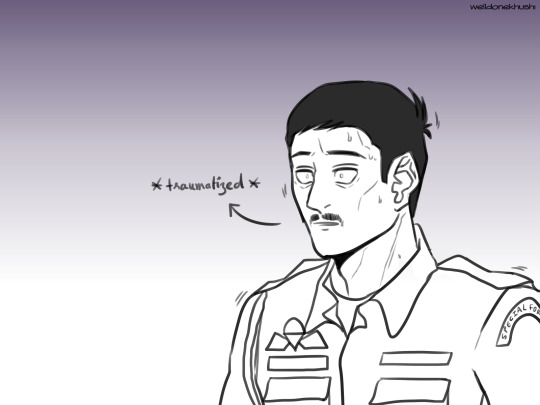
Had the idea if the personalities of Arjun and Aditya were switched, so what would the results be.
Well, Yuvraj's going to be traumatized for a while. 😝✨
#oc#oc art#oc fanart#original character#my ocs#my ocs art#indian oc#captain arjun#lieutenant yuvraj#lieutenant aditya#personality swap au
12 notes
·
View notes
Text
sometimes it genuinely escapes me that i have an identity that no one else has
i am me, yknow
#When you take an original character and slap on a new race or feature of identity to them you're saying you cant make an original characte#character with that kind of value.#like sometimes i forgot not everyone else is bengali American and when i find another one out in the wild its like#woah.... woah hi#and then it really like hits me yknow#cuz i can be as homo as i want. its easy to find others#but to find a bengali person with similar interests to me? i don't have that#aint even gotta be bengali. love my pakistani and indian siblings#and ig seein velma doin the race swappy thing#at first i was like “bro does it really matter all that much man like its a shit show stop getting angry over it” i was#honestly treating it lik rage bait lmaooo i still dont think its fully processed its not#but then i saw another bengali dude talk about it. like actually talk about it#and then it hit me like. i am south asian. this velma is south asian.#but is she actually? is this character I am seeing right now#is this what people see when they learn i am brown? is this what they imagine? is this an actual brown women?#and the answer is no. maybe if it was mindy kaling then yes it would be#now i cant say race swapping makes me angry. i don't care bro#literally its so much more EFFORT to care and why should i it'll all die down when its over#hate watching does nothing but fuel the things you dislike#but ig i rlly like sat down and thought about it. like rlly think about it#this character. even if the original ip WAS south asian. or even if this was an original character#its not perpetuating what its like. no no no not at all#its just putting the label on#making it known and#i dont know man i never expected stuff like this to irk me#i saw the guy i watch say this that stuck with me#smthn like that#and idk man#sorry for the rant but FUUUUUCK its hit me my identity is my identity
2 notes
·
View notes
Text
Acquired
My தங்கச்சி thought that taking things across the multiverse was wrong, as you were permanently removing matter from one universe and adding it to another. It was theft, she said. Thankfully, she didn’t know about my stash, so she couldn’t disapprove of it.
A pair of jeans. A piece of the 527th element, lab made, from the universe with the best snow in the multiverse. Armor that was meant to drape over a thousand-limbed species. அம்மா’s ring, no longer worn. The coating of a sessile species the precise color of the inside of a star.
They were everything. They meant nothing. I haven’t decided yet.
#To acquire something is to come into possession of it#what does it mean when a third person universe switches to first person?#in this case chaos#we love a dimension jumping magpie#creative writing#my writing#library of babel#unedited#original characters#my ocs#space romp#sci fi#science fiction#tamil indian american#tamilian#indian american
0 notes
Text
US-based Indian activist applauds initiative allowing diaspora contributions to Ram Mandir
Social activist Prem Bhandari had earlier appealed to prime minister Narendra Modi to allow members of the Indian diaspora across the world to contribute to the development of the Ram Temple in Uttar PradeshAsserting that there are over 3.5 crore Non-Resident Indians and Persons of Indian Origin around the world, he said that many of them would like to contribute to the development of the temple.
Read more- https://www.easterneye.biz/us-indian-activist-applauds-diaspora-contributions-to-ram-mandir/
#Ram Mandir#Indian diaspora#contributions#Shri Ram Janmbhoomi Teerth Kshetra#donations#Kimberly Rodrigues#temple construction#Ayodhya#Hindu Lord Ram#inauguration#January 22#2024#Prem Bhandari#New York#community activist#Narendra Modi#Overseas Friends of Ram Mandir#Non-Resident Indians#Persons of Indian Origin#development#Foreign Contribution Regulation Act (FCRA) 2010#Trust registration#Pran Pratishtha#deity installation#historic event#550 years#voluntary donations#global outreach#special occasion
0 notes
Text
Here is a brief summary of what is happening in Wikipedia right now:
In the last few years (3-4 years) the WikiProject Indigenous peoples of North America, which was originally created to improve the quality and coverage of native issues and native articles on wikipedia, has been hijacked by a small number of users with an extremist agenda. They have been working diligently over the last few years to change the definition of both what it means to be an Indigenous American and even what it means to be state and federally recognized.
The four or five key players (Mainly Editor Yuchitown, Bohemian Baltimore, ARoseWolf, (now retired editor CorbieVreccan, Netherzone and Oncamera) who are part of the “Native American Articles Improvement Project” started implementing these changes slowly, but they started pursuing their goals aggressively after November 2023, when state-recognized tribes retained their voting rights in NCAI. Essentially, after the movement to delegitimize state-recognized tribes failed officially, the key players doubled down on altering and controlling the flow of information about Native Americans through Wikipedia.
The talk page of Lily Gladstone’s article has a relevant discussion here. Initially, the leaders of the WikiProject removed any reference to her being a “Native American Actress” and instead had her as “Self-identifying as Blackfoot” and “Self-identifying as Nez Perce” because her blood quantum was too low to be enrolled in either tribe.
You can see some of the discussion here:
https://en.wikipedia.org/wiki/Talk:Lily_Gladstone
Eventually they relented and changed her category to being “Of Nez Perce Descent” but you can see in the discussion that they are referring to an article that these editors (Yuchitown, Bohemian Baltimore, and CorbieVreccan) themselves appeared to have mostly written and revised:
https://en.wikipedia.org/wiki/Native_American_identity_in_the_United_States
This statement is very much at odds with even the government’s description, as seen below;
The DOJ Office of Tribal Justice Office on their webpage “Frequently Asked Questions About Native American”, question “Who is an American Indian or Alaskan Native” states:
“As a general principle, an Indian is a person who is of some degree Indian blood and is recognized as an Indian by a Tribe and/or the United States. No single federal or tribal criterion establishes a person's identity as an Indian. Government agencies use differing criteria to determine eligibility for programs and services. Tribes also have varying eligibility criteria for membership.”
In addition, “List” pages have been created on Wikipedia for federally and state recognized tribes. The Wikipedia “List” page for state-recognized tribes is inaccurate in its interpretation of state recognition and not supported by expert reliable sources--(1) Cohen’s Handbook of Federal Indian Law 2012 edition, (2) NCSL.org current stand on state recognition (not the archived list from 2017 which NCSL no longer supports), (3) Koenig & Stein’s paper “Federalism and the State Recognition of Native American Tribes: a survey of state-recognized tribes and state recognition processes across the United States” (both 2008 & updated 2013 in book “ Recognition, sovereignty struggles, and indigenous rights in the United States: A sourcebook”)
https://en.wikipedia.org/wiki/State-recognized_tribes_in_the_United_States
State-recognized tribes who have received recognition through less formal but acceptable means have been moved from the Wikipedia list page on state-recognized tribes to the Wikipedia list page of unrecognized or self-identifying organizations.
The Wiki page "List of organizations that self-identify as Native American tribes", in particular, is being used to purposely defame legitimate Native American individuals who are members of the tribes/Native communities that are on this list.
By the parameters set up on Wikipedia, only the colonizer’s governments can acknowledge who is Native American through either federal recognition or state recognition. If an individual is not a member of a federally or state-recognized tribe, then it is determined that they cannot be Native American and are, instead, considered “self-identifying” or only “a descendant of ...” (example Lily Gladstone). As a result, Native individuals are currently being tagged as “self-identifying” and their names are put on “list” pages that strongly imply they are “pretend” Indians.
These editors have indicated that they would like “self-identification” to be the default setting for any people who they deem do not fit within the parameters that they themselves created within Wikipedia.
Moreof, these editors are admin and senior editors within the Wikiproject Indigenous Peoples of North America, and are being called in specifically to weigh on Native Identity, and any project involving any Indigenous Group.
Any attempt to correct misinformation, add information, or change any of these articles is often met with being blocked, reported for various offenses, or reported for having a Conflict of Interest, whether or not that is actually applicable. They have use this strategically in many different pages for many different individuals and groups within the scope of their Wikiprojects.
While changing things in Wikipedia does not change the truth, it is a way to control how most people take in information, and thus they hope to manipulate the narrative to better suit their goals.
This is quick and messy but:
Here is a link to the google document with the other state recognized tribes (Including yours) that were edited by these editors. This is an incomplete list so far that only goes back to September 2023 but I am going to add to it. If you can add to your own part of this list, and send your complaints and information to the arbitrator committee (the email is below) with the involved editors, this will help our case.
The more tribes who complain, and the more Wikipedia editors complain, the better our case will be.
https://docs.google.com/document/d/1YNDEjLTrrZ_mMIRCVxtvt69FwCYpJWKs71lBhWa5a9M/edit?usp=sharing
The place to make complaints on Wikipedia is oversight-en-wpwikipedia.org , and
arbcom-enwikimedia.org . It is most helpful to have an editing account on Wikipedia, because Yuchitown and the others will try to defend themselves using Wikipedia methodology and make anyone who confronts them look like the aggressor (see the other tribes who tried to fight back on Wikipedia I found).
The more people and tribes make complaints the more likely it is that this will work and we can rid ourselves of these monsters.
Some of the tribes I have spoken to are taking legal action against these editors. Any groups affected by their policies should also reach out to the news to make knowledge of this more widespread.
Thank you
- quoted with permission from an email sent by an associate of my tribe. Message me for their email address if you'd like to reach out to them.
#indigenous#intertribal infighting#state recognized tribes#seaconke Wampanoag#our chief and first councilman were at NCAI and there was ver nearly physical violence about this issue#Seaconke Wampanoag is recognized in MA and currently pursuing recognition by RI#like we gave active bills in tge state house
7K notes
·
View notes
Text

👉 Experience The Transformative Power of our 𝐇𝐀𝐈𝐑 𝐓𝐑𝐀𝐍𝐒𝐏𝐋𝐀𝐍𝐓 🧔 Feel Like a Brand New Person!
👉 Get The Results you want with our customized Hair Transplant 🧔 like 🏏 #Hanuma_Vihari ( Indian Cricketer )
👉 Visit @monarishair - Monaris Hair Clinic today and get a chance to regain your original hair back.
🤙Consult Now! with Our Experienced @drsurana - Dr. Arihant Surana (Dermatologist & Hair Transplant Surgeon )
🤙 Book Your Slot Now!
☎ +91 98186 42643
🌐 https://www.monarishair.com
📧 Email: [email protected]
✅ WhatsApp Chat: https://wa.me/919818642643
🏨 E 13, 1st Floor, Ring Rd, Defence Colony, New Delhi, Delhi 110024
#dr. arihant surana / monaris hair clinic -india#👉 Experience The Transformative Power of our 𝐇𝐀𝐈𝐑 𝐓𝐑𝐀𝐍𝐒𝐏𝐋𝐀𝐍𝐓 🧔 Feel Like a Brand New Person!#👉 Get The Results you want with our customized Hair Transplant 🧔 like 🏏#Hanuma_Vihari ( Indian Cricketer )#👉 Visit @monarishair - Monaris Hair Clinic today and get a chance to regain your original hair back.#🤙Consult Now! with Our Experienced @drsurana - Dr. Arihant Surana (Dermatologist & Hair Transplant Surgeon )#🤙 Book Your Slot Now!#☎ +91 98186 42643#🌐 https://www.monarishair.com#📧 Email: [email protected]#✅ WhatsApp Chat: https://wa.me/919818642643#🏨 E 13#1st Floor#Ring Rd#Defence Colony#New Delhi#Delhi 110024#.#HanumaVihari#HairTransplantRecovery#DrArihantSurana#HairTransformation#RecoveryPeriodofHairTransplant#HairTransplantCostinIndia#AHT#ahthairtransplant#hairtreatment#hairtransplant#monarishairclinic
1 note
·
View note
Text
Emerald Spectacles from India, c. 1620-1660 CE: the lenses of these spectacles were cut from a single 300-carat emerald, and it was believed that they possessed mystical properties

These eyeglasses are also known by the name "Astaneh-e ferdaws," meaning "Gate of Paradise," based on the symbolic associations between the color green and the concept of spiritual salvation/Paradise. That symbolism (which is rooted in Islamic tradition) was especially popular in Mughal-era India, where the spectacles were made.
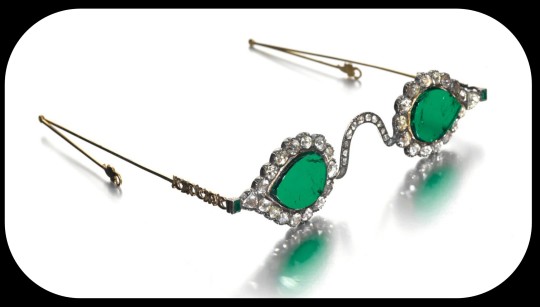
The lenses were crafted from two thin slices of the same emerald. Together, the lenses have a combined weight of about 27 carats, but given the precision, size, and shape of each lens, experts believe that the original emerald likely weighed in excess of 300 carats (more than sixty grams) before it was cleaved down in order to produce the lenses. The emerald was sourced from a mine in Muzo, Colombia, and it was then transported across the Atlantic by Spanish or Portuguese merchants.
Each lens is encircled by a series of rose-cut diamonds, which run along an ornate frame made of gold and silver. The diamond-studded frame was added in the 1890s, when the original prince-nez design was fitted with more modern frames.
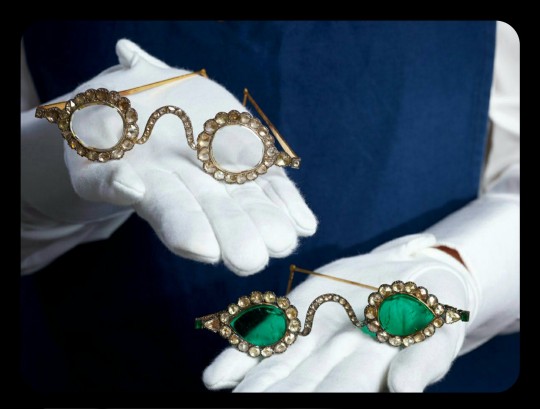
The emerald eyeglasses have long been paired with a second set of spectacles, and they were almost certainly commissioned by the same patron. This second pair is known as "Halqeh-e nur," or the "Halo of Light."
The Halo of Light features lenses that were made from slices of diamond. The diamond lenses were cleaved from a single stone, just like the emerald lenses, with the diamond itself being sourced from a mine in Southern India. It's estimated that the original, uncut diamond would have weighed about 200-300 carats, which would make it one of the largest uncut diamonds ever found.

The lenses are so clear and so smoothly cut that it sometimes looks like they're not even there.
Both sets of spectacles date back to the mid-1600s, and it's generally believed that they were commissioned by a Mughal emperor or prince. The identity of that person is still a bit of a mystery, but it has been widely speculated that the patron was Shah Jahan -- the Mughal ruler who famously commissioned the Taj Mahal after the death of his wife, Mumtaz Mahal. Shah Jahan did rule as the Mughal emperor from about 1628 to 1658.
The emerald and diamond lenses may have been chosen for symbolic, sentimental, and/or cultural reasons, or they may have been chosen simply because they're pretty and extravagant; the original meaning and purpose behind the design is still unclear. Experts do believe that the eyeglasses were designed to be worn by someone, though.
At times, it was believed that the spectacles had spiritual properties, like the ability to promote healing, to ward off evil, to impart wisdom, and to bring the wearer closer to enlightenment. Those beliefs are largely based on the spiritual significance that emeralds and diamonds can have within certain Indic and Islamic traditions -- emeralds may be viewed as an emblem of Paradise, salvation, healing, cleansing, and eternal life, while diamonds are similarly associated with enlightenment, wisdom, celestial light, and mysticism.
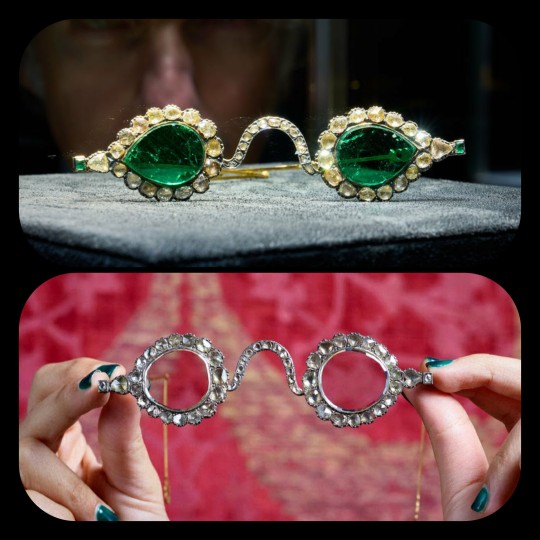
The Gate of Paradise and the Halo of Light were both kept in the collections of a wealthy Indian family until 1980, when they were sold to private collectors, and they were then put up for auction once again in 2021. They were most recently valued at about $2 million to $3.4 million per pair.
Sources & More Info:
Sotheby's: Mughal Spectacles
Architectural Digest of India: At Sotheby's auction, Mughal-era eyeglasses made of diamond and emerald create a stir
Only Natural Diamonds: Auspicious Sight & the Halqeh-e Nur Spectacles
The Royal Society Publishing: Cleaving the Halqeh-Ye Nur Diamonds
Gemological Institution of America: Two Antique Mughal Spectacles with Gemstone Lenses
Manuscript: From Satan's Crown to the Holy Grail: emeralds in myth, magic, and history
CNN: The $3.5 million Spectacles Said to Ward off Evil
BBC: Rare Mughal Era Spectacles to be Auctioned by Sotheby's
#history#archaeology#artifact#mughal#india#17th century#art#emerald#diamond#glasses#indian lore#islam#religion#mysticism#indian history#anthropology#spirituality#fashion
4K notes
·
View notes
Text
Evidence that Kabru from Delicious in Dungeon is Indian, a Masterpost
(Some of this info is taken from my upcoming essay about the names and cultural origins of all the characters in Dungeon Meshi. There's a link in the source to the AO3 version of this essay.)
Since Kabru’s first appearance in the anime is upon us, I wanted to write something that compiles all the evidence we have that Kabru is meant to be a person of South or Central Asian ethnicity, or at least whatever the equivalent to that is in the Dungeon Meshi world.
Ryoko Kui can and does draw people of many different ethnicities, and the way she draws Kabru matches the way she draws other Asian characters in Dungeon Meshi. He doesn’t look Black, or Hispanic, or any other ethnicity because he isn’t supposed to. He looks like a dark-skinned South or Central Asian person, because that’s what Ryoko Kui probably intends him to be.
So let’s go through the evidence!
(There are no spoilers for the plot of Dungeon Meshi below, but there ARE spoilers for Kabru's backstory as explained in the manga, and in extra materials like the Daydream Hour and Adventurer's Guide book.)
KABRU’S NAME
The Dungeon Meshi Adventurer's Bible tells us Kabru’s real name is unknown. There are other characters whose real names are only told to us in the Adventurer's Bible and were never revealed in the manga, but then Kabru, Thistle and Izutsumi’s entries simply say their real names are unknown, and though Kui could tell us their true names, she doesn’t. I assume this means that the characters themselves don’t know what their real names are, and that the names they go by are not their birth names, but this is only a supposition on my part.
KABRU THE MOUNTAIN
Kabru (काब्रु) is the name of a mountain on the border of Nepal and India, and part of the Himalayan range. It’s the 65th tallest mountain in the world and it is very snowy and icy, with frequent avalanches. Because of this, even though it’s not the tallest mountain in the world, climbing it is challenging, and is not often attempted. Those few that have managed to climb it consider it a major achievement.
“This prohibitively fearful icefall… had thwarted numerous expeditions, perhaps even the 'thought' of attempting the mountain… Unstable seracs of the icefall, a complex maze of chasms, and delicate snow bridges spanning seemingly never ending, near bottomless crevasses… Each time the members stepped into the icefall, they stood a good chance of never returning.” (Kabru - Mountain of the Gods, Major A. Abbey, Himalayan Journal 52, 1996, editor Harish Kapadia)
WHAT DOES KABRU’S NAME MEAN?
Kabru is a character that is known for being very good at charming people, but who doesn’t express himself honestly, because he’s trying to manipulate the people and situations around him in order to maintain control at all times. I think nobody really knows who Kabru is deep inside, maybe not even Kabru himself, so a remote, hostile, icy mountain that’s hard to climb seems like an extremely appropriate name.
Some of the oldest English sources I found regarding Kabru suggest that Kabru isn’t the correct local name for the mountain (a common problem in early Himalayan exploration by Europeans) and might just be a descriptor, or that it’s a misspelling.
This makes the name seem even more appropriate, since Kui’s told us Kabru’s true name is unknown. It’s possible that Kabru was a place-name or a descriptor that Milsiril (Kabru’s elven foster mother) was given when she picked up a traumatized 7 year old Kabru, and she just started using it as his name, and that even he doesn’t remember his real name thanks to his severe trauma.
The fact that people in the real world can’t seem to agree on the mountain Kabru’s name, or what it means, reminds me of the running gag of Laios repeatedly getting Kabru’s name wrong in the manga.
"All the people near the Kabru massif call it 'Kaboor'." (The Alpine Journal, 1921-22 Volume 34, Edited by George Yeld and J. P. Farrar)
“It is also said that the name applies to a peak close to Kinchinjunga on the southeast, and not to the peak known to Europeans as Kabru… [The real name is] Pahung Ri [Pauhunri].” (Appendix I: Place Names in Darjeeling. The appendix says it was “compiled mainly from an article written by Colonel Waddell and published in the Journal of the Asiatic Society of Bengal (Vol. LX, part I, 1891)”)
“Kangchen is a Tibetan name… the Sikkhimese use it as the name for the peak called Kabru by Europeans.” (Charles Bell, Dyhrenfurth's Himalaya (Berlin, 1931))
“...Kyabru or the horn of protection. The name is… Kabur… possibly a corruption of Kangbur or the swelling of snow; it might also mean the white swelling (kar-bur).” (Appendix I: Place Names in Darjeeling.)
“Kabru literally means the 'White Avalanche' peak (Ka means 'white' and bru means 'avalanche').” (Kabru - Mountain of the Gods, Major A. Abbey, Himalayan Journal 52, 1996, editor Harish Kapadia)
I’ve seen one other mountaineering article cite the “white avalanche” meaning, and I think it’s plausible since the Appendix says it can mean “white swelling” or “swelling of snow”, which may very well be a literal translation for “white avalanche”.
WHAT ABOUT UTAYA? IS THAT INDIAN TOO?
Utaya means “raised” or “uplifted” in Hindi, but it’s also a real village and a Japanese boy’s name.
Utaya (ウタヤ) is the name of the village that Kabru was raised in before his mother died and he was adopted by the elf Milsiril. Utaya is located in the southeast of the Western Continent. It’s worth noting that Kabru probably wasn’t born in Utaya, since his mother had to flee from her home to keep Kabru alive, so Utaya may be some distance away from his birth place… Not so far that a woman with a newborn baby couldn’t survive the trip, but far enough that her husband’s family gave up on chasing her. So Kabru was probably born in a close-by area.
In the real world, Utaya (Yakut: Утайа) is in an extremely rural and isolated area with a population of less than a hundred people. It’s located in the Sakha Republic, which is in the Northeastern part of Asia in the Russian Federation. The Yakut/Sakha are a Siberian Turkic people.
The Turkic peoples are a collection of diverse ethnic groups of West, Central, East, and North Asia as well as parts of Europe, who speak Turkic languages.
Early and medieval Turkic groups exhibited a wide range of both East Asian and West-Eurasian physical appearances and genetic origins, in part through long-term contact with neighboring peoples such as Iranian, Mongolic, Tocharian, Uralic/Yeniseian peoples, and others. Turkic peoples share, to varying degrees, non-linguistic characteristics like cultural traits, ancestry from a common gene pool, and historical experiences.
JAPANESE MEANINGS FOR UTAYA
Utaya can be a Japanese boy’s name with several different meanings, depending on which kanji it’s spelled with.
In most of the spellings: Poetry, sing a poem, singing, compose poetry
In many of the spellings: The place where the sun shines, it's been a long time, distant, big, to shoot with a bow, to swear, affirmation, question.
The Utaya disaster happened a long time ago.
If Utaya is up in the mountains above the clouds it’s a place where the sun shines brightly.
Kabru has sworn to himself that he will prevent another Utaya tragedy from happening.
In only a few of the spellings: to mend, feathers, wings, a word for counting birds and rabbits, sort them out, washing with water to separate the good from the bad, roof, house with a roof, a world covered with a big sky, infinite space, song that praises the Buddha, Eight.
Counting birds and rabbits makes me think of divination and also that the people of Utaya were like little birds and rabbits (small prey animals) to the monsters that devoured them.
Separating the good and the bad could hint to the “judgment” of Utaya and the greed of its people that led to their downfall, also sorting through things to separate good and bad is something that’s done with food and other resources.
The Himalayan region is often referred to as the “roof of the world”, with a big open sky above it.
The infinite could refer to the dimension the demon comes from, or to the sky above the mountains.
Buddhism is a common religion in the Himalayan region, and eight has auspicious connotations in Buddhism.
With all that in mind, Utaya as a name for Kabru’s home village is an interesting choice, and adds another layer to his origins, maybe suggesting not just North Indian/Himalayan, but Central or North Asian cultural influence as well.
It is also possible that the name is just telling us that Utaya is “up” in the mountains, or that it was “uplifted” by the wealth of the dungeon, or even that Kabru was “raised” there… The Japanese name meanings are also extremely fascinating and hint at similar ideas, as well as the tragedy that happened to Utaya.
WHY ELSE DO YOU THINK KABRU AND UTAYA ARE HIMALAYAN?
In the real world, the Himalayan mountain range is an extremely popular tourist destination, and the amount of people who want to visit and attempt to climb the mountains far outpaces the local ability to support it. This makes me think of the dungeon of Utaya and how people overcrowded it in their desire to conquer and exploit it.
Dungeons as an unsustainable way for locals to make a living that leads to the destruction of their homes when the dungeon inevitably collapses is a major plot point in Dungeon Meshi, so I think the parallel is likely intentional. Characters often talk about someone “conquering” the dungeon, and “conquer” is also the terminology commonly used for climbing a mountain. This terminology obviously has a hostile, imperialist subtext in the real world, since it’s most commonly used by outsiders talking about proving their strength by climbing a mountain.
Also, there are local legends in the areas surrounding Mt. Kabru that there is a valley of immortality hidden on its slopes, which reminds me of the way that the dungeons can grant conditional immortality to the people inside of them.

This image of Utaya could be showing us a village built on a mountainside. The house shapes seem a bit more Middle Eastern than Nepali/Indian, but it’s not a detailed drawing and the roof styles are a mix of flat and peaked.
CULTURE
In the Daydream Hour sketchbook, Ryoko Kui included a small comic about characters sharing desserts from their home countries. A young Kabru is shown enthusiastically trying to share an unnamed sweet, and he is interrupted by his elven foster mother, who insists he present a type of elven cake instead. We know that Kabru hates this type of cake, and he seems disappointed to have to eat it and talk about it.

The white balls in Kabru’s dessert are very likely meant to be an Indian sweet called rasgulla (literally "syrup filled ball"). Rasgulla are a dessert popular in the eastern part of South Asia, made from ball-shaped dumplings of chhena dough, cooked in light sugar syrup. While it is near-universally agreed upon that the dessert originated in the eastern Indian subcontinent, the exact origin is disputed. Rasgulla are as culturally important to the Bengal and Odisha regions of India as Parmesan cheese is to the region of Parma in Italy.
Rasgulla are also popular in Nepal, where they are called rasbari.
KABRU’S PHYSICAL APPEARANCE

Kabru is one of several characters in Dungeon Meshi with clearly non-European features: he has brown skin and thick black/dark brown curly hair. He has almond-shaped eyes with long, dark lashes (fans like to joke that he’s wearing eyeliner). All of these are traits common to people from the Indian subcontinent. His blue eyes are not common for someone with his skin/hair color, but blue or green eyes are not unheard of in that region either.
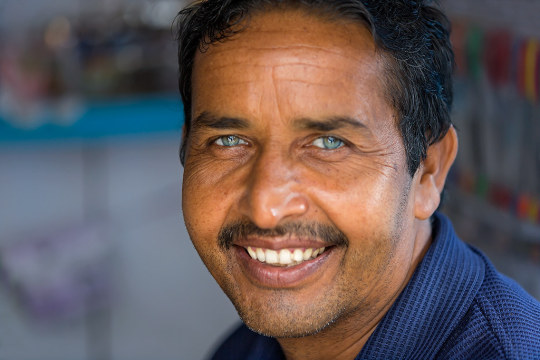
(Indian man with blue eyes)
Blue or light eyes are often a cause for discrimination, like what Kabru experienced as a child. More on this in a moment.
Kabru is 5’7” (170cm) tall, which is short for a Northern European man (180), tall for a Nepali man (162cm), but close to the average height of Indian men (177cm). He has a slender build, which is also common for Asian people in general, and South Asian men in particular.

Compared to the European-looking tall-men in Dungeon Meshi (such as Laios, Falin, Delgal, Marcille’s father), Kabru’s facial features look more like the other Asian characters, such as Toshiro and his party.
CAN DARK-SKINNED PEOPLE HAVE BLUE EYES?
Yes. Light-colored eyes are very uncommon in parts of the world where most people have dark eyes, since dark eyes are a dominant trait in real-world human beings. That means that in order for two parents with dark eyes to have a child with light eyes, both parents need to have a recessive light-eyes gene (or for there to be an illness or genetic mutation), and that’s rare in populations that don’t have a lot of light-eyed people to begin with.
THEN WHY DO SO MANY DARK-SKINNED CHARACTERS HAVE BLUE EYES?
Anime and manga often give characters with dark skin light colored eyes instead of allowing them to have brown or black eyes, which is much more common in real life. It’s a hurtful design trope that makes many readers feel that their natural dark eyes are somehow ugly or inferior to blue eyes.
This trope is used over and over again by authors who want their characters to look “cool” and “exotic”, and for their eyes to be high-contrast to make it easier to show their emotions.
I don’t think this is what Ryoko Kui is doing in Dungeon Meshi.
UNREALISTIC HAIR AND EYE COLOR COMBOS IN ANIME
In a lot of anime/manga, blue eyes (regardless of skin color) don’t actually mean anything in the narrative, in the same way characters having green or pink hair doesn’t mean anything, the colors are non-diegetic, they don’t actually exist in the world, like the music that plays in the background without an on-screen source.
It’s an artistic shorthand to make characters visually stand out, instead of giving them all black hair and eyes like most real-life Japanese people… Which is what most anime/manga characters are meant to be: Japanese people.
Dungeon Meshi has a large cast of characters that are explicitly meant to be non-Japanese. We know this because there’s a group of characters that are Japanese, and they’re drawn differently from everyone else, they wear ethnically Japanese clothing, and have ethnically Japanese names.
Unlike other series, where eye and hair color don’t mean anything, Dungeon Meshi has no unrealistic skin, hair, or eye color combinations.
(Except for the elves, who seem to have different genetics than real world-humans. I’ll get into that another time.)
Ryoko Kui must be aware of the dark skin, blue-eyes design trope, because if she gave Kabru blue eyes just because she thought it looked good, surely she would have made some of the other Asian or dark-skinned characters have light eyes. Out of 9 Asian or dark-skinned tall-man characters, Kabru is the only one with blue eyes.
Kabru having light-colored eyes is central to his story, and Kui talks about it.
KABRU’S STORY AND WHY HIS BLUE EYES MATTER
Kabru’s father and his family tried to kill Kabru when he was born because he had blue eyes. Kabru’s mother ran away, and ended up raising Kabru by herself in Utaya. She didn’t try to return home to her own birth family, but instead struggled to raise a child completely on her own with no money or support, which implies she had no other options, due to the fear people of their region have for people with blue eyes.
This is a real thing that used to happen frequently in areas where most of the population has dark eyes, and it still happens to this day.
In a realistic story, this is logically what would happen to a character with dark skin born with blue eyes in a place like the Utaya region. It’s rare for manga or anime to show dark-skinned blue-eyed characters facing this.
WHAT IS THE “EVIL EYE”?
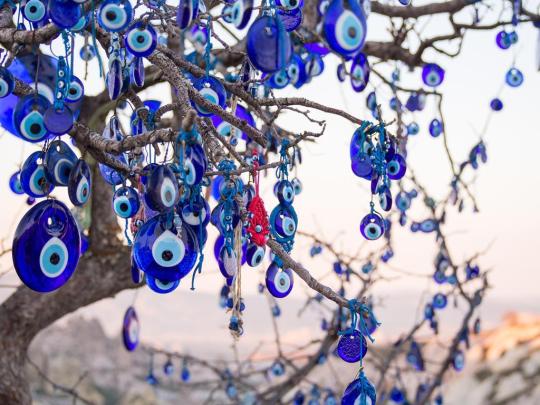
The “evil eye” is a supernatural belief in a curse brought about by a person looking at you. The belief in the evil eye has existed since prehistory, as long as 5,000 years ago. It is estimated that around 40% of the modern world's population believes in the evil eye. This concept is most common across the Mediterranean, the Balkans, the Middle East, and Central and South Asia, areas where light-colored eyes are uncommon.
In areas where light-colored eyes are rare, people with green eyes, and especially blue eyes, are thought to bestow the curse, intentionally or unintentionally. Just one look from a blue-eyed person is often considered enough to inflict a curse.
One of the most famous and widespread talismans against the evil eye is the nazar, a glass amulet featuring concentric circles in dark blue, white, light blue and black. It’s supposed to “bounce” the curse away from the wearer.
HOW DOES THIS APPLY TO KABRU?
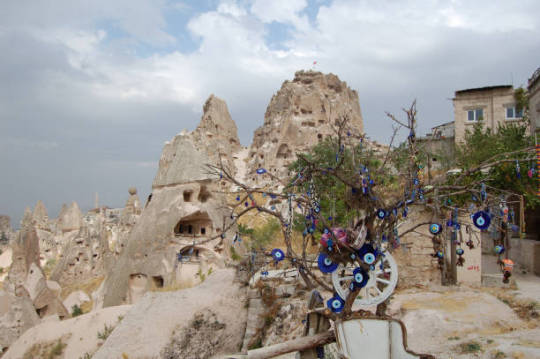
Imagine Kabru growing up in a village surrounded by people wearing and hanging talismans that look like his eyes, because the people around him think blue eyes are evil. They call his mother a witch for birthing him, and a whore because she doesn’t have a husband. Imagine parents forbidding their children from playing with or even talking to Kabru. People crossing the street to get away from him, or chasing him away by throwing rocks.
I think the reason young Kabru was able to learn how to speak some kobold is likely because he was so heavily ostracized by the other tall-men around him, the only children he could occasionally interact with in Utaya were kobolds, who might not share the same cultural superstitions that the tall-man do.
This childhood trauma, combined with Kabru’s experience of the dungeon collapse in Utaya, and being raised by an elf that treated him more like a pet than a human being, set Kabru up as a character who has never had a home where he belongs. He has been an outsider from the instant he was born, and every place he has lived treats him as an “other.”
To his father’s family, he was a curse. To his mother, although she loved him, he was a burden. To the people of Utaya, he was a monster. To the elves, he’s a tall-man baby (no matter how old he gets) with funny looking eyes, to the people on Merini Island, he’s a foreigner from the West with elven ways and education.
CONCLUSION
I wanted to write this because I know some people will see Kabru in the anime for the first time today and think "Oh, another dark skinned blue eyed character! This is a bad character design that is evidence that the author is racist at worst or ignorant at best.” And I don’t think that’s a fair assessment of Ryoko Kui’s work in Dungeon Meshi.
This isn’t to say that Ryoko Kui has never done anything wrong, or that her work couldn’t be more inclusive, or that there’s no way in which she could improve.
But there are pages and pages of artwork she’s done that shows she cares about these issues, and I think it’s worth celebrating when someone makes that kind of effort with their artwork.
ANYWAY…
If you’ve read this far, you’re very strong hahaha. I hope you enjoyed this essay. I’ll be publishing more soon when I finish my Dungeon Meshi research on the names and cultures of all the characters. Wish me luck!
#dungeon meshi#delicious in dungeon#dunmeshi#kabru#my stuff#analysis#character of color#theories#Dungeon Meshi Research
1K notes
·
View notes